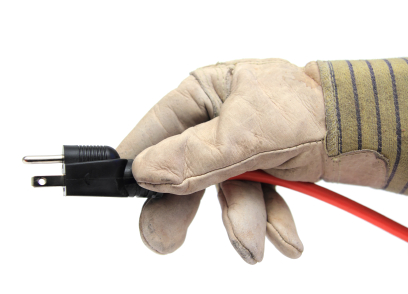Adapt this list of reminders to your working environment. Be sure to consider company policies and local, state, and Federal codes before establishing a written electrical safety program.
- Plan every job and think about what could go wrong.
- Use the right tools for the job.
- Wear correct safety footwear and clothing to help prevent injury.
- Use procedures, drawings, and other documents to do the job.
- Isolate equipment from energy sources.
- Identify the electric shock and arc flash, as well as other hazards that may be present.
- Minimize hazards by guarding or establishing approach limitations.
- Test every circuit and every conductor every time before you touch it.
- Use personal protective equipment (PPE) as a last line of defense in case something goes wrong.
- Be sure you are properly trained and qualified for the job.
- Work on electrical equipment and conductors only when deenergized, unless procedures and safeguards have been established to ensure zero exposure for the worker and other people in the area.
- Lockout/tagout and ground (where appropriate) before working on equipment.
- Treat de-energized electrical equipment and conductors as energized until lockout/tagout, test, and ground procedures (where appropriate) are implemented.
- Wear fire-resistant clothing. Review FR ratings for your work conditions to safely decide which FR fabrics are best for you.
- Use insulated tools and protective equipment in areas where there are possible electrical hazards.
- De-energize and visibly guard (where possible) whenever contact with uninsulated overhead power lines is possible.
- Check and double check safety regulations when a ladder or parts of any vehicle or mechanical equipment structure will be elevated near energized overhead power lines. Call your local electric utility for assistance. People standing on the ground may be particularly vulnerable to possible injury.
Tools Equipment and Tool Grounding
- Make sure all equipment and extension cords bear the mark of an independent testing laboratory such as UL, CSA, ETL or MET Labs.
- Protect flexible cords and cables from physical damage. Check cords for cut, broken, or cracked insulation.
- Keep slack in flexible cords to prevent tension on electrical terminals.
- Make sure the insulating qualities of a splice are equal to or greater than the original cord.
- Extension cords are for temporary use. Install permanent wiring when use is no longer temporary.
- Verify that all three-wire tools and equipment are grounded.
- Water, electrical equipment, and power cords do not mix! Use GFCI protection in wet or damp environments.
- Ground exposed parts of fixed equipment that could be energized.
- Use non-conductive tools whenever possible.
- Always double check the operation of your voltage testers by testing a live circuit.
Other Considerations
- Verify location of all buried or embedded electrical circuits before digging or cutting.
- Determine the reason that a fuse operated or circuit breaker tripped before replacing or resetting.
- Know where your overcurrent devices are (i.e. circuit breakers and fuses) so they can be easily and quickly reached in case of emergency.
- When replacing lamps and bulbs, verify that the replacement matches fixture requirements.
Electrical Safety Documents
Many organizations are committed to developing standards, regulations and guidelines that include electrical safety requirements. Employees in the workplace should familiarize themselves with these documents and the organizations responsible for their development. Some of these standards, guidelines and regulations are:
- OHSA Regulations
- OSHA 29 CFR 1910, General Industry
- Subpart – Electrical Standard
- Subpart R – Utility Industry
- 1910.268 Telecommunications
- 1910.269 Power Generation, Transmissions and Distribution Standard
- Subpart J, 1910.147 – Lockout/Tagout
- Subpart K – Electrical Standard
- Subpart V – Power Transmission and Distribution




